An Approach to Refining MODIS LAI Data Using a Fitting Scale Factor Time Series
Abstract
1. Introduction
2. Materials and Methods
2.1. Study Region
2.2. Data Collection and Processing
2.2.1. MODIS MOD15A2H
2.2.2. Land Use Type Datasets
2.2.3. Measured LAI Datasets
2.2.4. Phenology Observations of Spring Maize
2.3. Methodology
2.3.1. S–G Upper Enveloped Filter
2.3.2. Spring Maize Purity Calculation
2.3.3. Upscaling MODIS LAI
- (i)
- The 500-m resolution LAI data is processed using the S–G upper envelope filtering;
- (ii)
- The MODIS LAI is masked using spring maize distribution data to exclude non-maize pixels;
- (iii)
- The average MODIS LAI value within the 5-km grid is calculated from the masked 500-m data and used as the upscaled LAI value.
2.3.4. Scale Factor Fitting
Scale Factor Time Series Fitting Without Purity
Scale Factor Time Series Fitting with Purity
2.3.5. Validation of Adjusted LAI Accuracy
3. Results
3.1. Validation Result of Upscaled LAI
3.2. Spring Maize Pixel Purity
3.3. Scale Factor Fitted with Different Methods and Pixel Purities
3.4. Comparison of Adjusted Result with Measured LAI
3.4.1. Adjust LAI for Fitting Scale Factors Without Purity
Accuracy of the 2011–2012 Reserved Validation Dataset
Accuracy of the 2016–2020 Validation Dataset
3.4.2. Adjust LAI for Fitting Scale Factors with Purity
Accuracy of the 2011–2012 Reserved Validation Dataset
Accuracy of the 2016–2020 Validation Dataset
3.5. Comparison of Accuracy Results for Adjusted LAI
3.6. Spatially Adjusted Results of the MODIS LAI in the NEC
4. Discussion
4.1. Feasibility of Adjusting LAI Using Scale Factors Fitted with Purity
4.2. Uncertainties and Limitations
5. Conclusions
Author Contributions
Funding
Data Availability Statement
Conflicts of Interest
References
- Han, D.; Cai, H.; Zhang, L.; Wen, Y. Multi-sensor high spatial resolution leaf area index estimation by combining surface reflectance with vegetation indices for highly heterogeneous regions: A case study of the Chishui River Basin in southwest China. Ecol. Inform. 2024, 80, 102489. [Google Scholar] [CrossRef]
- Du, L.; Yang, H.; Song, X.; Wei, N.; Yu, C.; Wang, W.; Zhao, Y. Estimating leaf area index of maize using UAV-based digital imagery and machine learning methods. Sci. Rep. 2022, 12, 15937. [Google Scholar] [CrossRef] [PubMed]
- Fang, H.; Wang, Y.; Zhang, Y.; Li, S. Long-Term Variation of Global GEOV2 and MODIS Leaf Area Index (LAI) and Their Uncertainties: An Insight into the Product Stabilities. J. Remote Sens. 2021, 2021, 9842830. [Google Scholar] [CrossRef]
- Zare, H.; Viswanathan, M.; Weber, T.K.D.; Ingwersen, J.; Nowak, W.; Gayler, S.; Streck, T. Improving winter wheat yield prediction by accounting for weather and model parameter uncertainty while assimilating LAI and updating weather data within a crop model. Eur. J. Agron. 2024, 156, 127149. [Google Scholar] [CrossRef]
- Ma, Y.; Wang, W.; Jin, S.; Li, H.; Liu, B.; Gong, W.; Fan, R.; Li, H. Spatiotemporal variation of LAI in different vegetation types and its response to climate change in China from 2001 to 2020. Ecol. Indic. 2023, 156, 111101. [Google Scholar] [CrossRef]
- Tao, F.; Palosuo, T.; Rötter, R.P.; Díaz-Ambrona, C.G.H.; Inés Mínguez, M.; Semenov, M.A.; Kersebaum, K.C.; Cammarano, D.; Specka, X.; Nendel, C.; et al. Why do crop models diverge substantially in climate impact projections? A comprehensive analysis based on eight barley crop models. Agric. For. Meteorol. 2020, 281, 107851. [Google Scholar] [CrossRef]
- Sisheber, B.; Marshall, M.; Mengistu, D.; Nelson, A. The influence of temporal resolution on crop yield estimation with Earth Observation data assimilation. Remote Sens. Appl. Soc. Environ. 2024, 36, 101272. [Google Scholar] [CrossRef]
- Zhuo, W.; Huang, J.; Xiao, X.; Huang, H.; Bajgain, R.; Wu, X.; Gao, X.; Wang, J.; Li, X.; Wagle, P. Assimilating remote sensing-based VPM GPP into the WOFOST model for improving regional winter wheat yield estimation. Eur. J. Agron. 2022, 139, 126556. [Google Scholar] [CrossRef]
- Huang, J.; Gómez-Dans, J.L.; Huang, H.; Ma, H.; Wu, Q.; Lewis, P.E.; Liang, S.; Chen, Z.; Xue, J.-H.; Wu, Y.; et al. Assimilation of remote sensing into crop growth models: Current status and perspectives. Agric. For. Meteorol. 2019, 276–277, 107609. [Google Scholar] [CrossRef]
- Huang, J.; Sedano, F.; Huang, Y.; Ma, H.; Li, X.; Liang, S.; Tian, L.; Zhang, X.; Fan, J.; Wu, W. Assimilating a synthetic Kalman filter leaf area index series into the WOFOST model to improve regional winter wheat yield estimation. Agric. For. Meteorol. 2016, 216, 188–202. [Google Scholar] [CrossRef]
- Jin, H.; Li, A.; Wang, J.; Bo, Y. Improvement of spatially and temporally continuous crop leaf area index by integration of CERES-Maize model and MODIS data. Eur. J. Agron. 2016, 78, 1–12. [Google Scholar] [CrossRef]
- Huang, X.; Zhao, Y.; Guo, T.; Mao, X. Enhancing SWAP simulation accuracy via assimilation of leaf area index and soil moisture under different irrigation, film mulching and maize varieties conditions. Comput. Electron. Agric. 2024, 218, 108625. [Google Scholar] [CrossRef]
- Song, B. Validation of Coarse-Resolution LAI Products over Chinese Croplands Using Field Measurements. Ph.D. Thesis, University of Chinese Academy of Sciences, Aerospace Information Research Institute, Chinese Academy of Sciences, Beijing, China, 2022. [Google Scholar] [CrossRef]
- Fang, H.L. Scaling effects of the true and effective Leaf Area Index (LAI and LAIe) and Clumping Index (CI). J. Geo-Inf. Sci. 2021, 23, 1155–1168. [Google Scholar] [CrossRef]
- Fang, H.; Zhang, Y.; Wei, S.; Li, W.; Ye, Y.; Sun, T.; Liu, W. The Field Measurements and High Resolution Reference LAI Data in Hailun and Honghe, China [Dataset]; Pangaea: Bremen, Germany, 2019. [Google Scholar] [CrossRef]
- Duveiller, G.; Baret, F.; Defourny, P. Using Thermal Time and Pixel Purity for Enhancing Biophysical Variable Time Series: An Interproduct Comparison. IEEE Trans. Geosci. Remote Sens. 2013, 51, 2119–2127. [Google Scholar] [CrossRef]
- Dong, T.; Liu, J.; Qian, B.; He, L.; Liu, J.; Wang, R.; Jing, Q.; Champagne, C.; McNairn, H.; Powers, J.; et al. Estimating crop biomass using leaf area index derived from Landsat 8 and Sentinel-2 data. ISPRS J. Photogramm. Remote Sens. 2020, 168, 236–250. [Google Scholar] [CrossRef]
- Jin, X.; Li, Z.; Yang, G.; Yang, H.; Feng, H.; Xu, X.; Wang, J.; Li, X.; Luo, J. Winter wheat yield estimation based on multi-source medium resolution optical and radar imaging data and the AquaCrop model using the particle swarm optimization algorithm. ISPRS J. Photogramm. Remote Sens. 2017, 126, 24–37. [Google Scholar] [CrossRef]
- Fan, X.; Gao, P.; Zhang, M.; Cang, H.; Zhang, L.; Zhang, Z.; Wang, J.; Lv, X.; Zhang, Q.; Ma, L. The fusion of vegetation indices increases the accuracy of cotton leaf area prediction. Front. Plant Sci. 2024, 15, 1357193. [Google Scholar] [CrossRef]
- Bandaru, V.; Yaramasu, R.; Jones, C.; César Izaurralde, R.; Reddy, A.; Sedano, F.; Daughtry, C.S.T.; Becker-Reshef, I.; Justice, C. Geo-CropSim: A Geo-spatial crop simulation modeling framework for regional scale crop yield and water use assessment. ISPRS J. Photogramm. Remote Sens. 2022, 183, 34–53. [Google Scholar] [CrossRef]
- Dong, T.; Liu, J.; Qian, B.; Zhao, T.; Jing, Q.; Geng, X.; Wang, J.; Huffman, T.; Shang, J. Estimating winter wheat biomass by assimilating leaf area index derived from fusion of Landsat-8 and MODIS data. Int. J. Appl. Earth Obs. Geoinf. 2016, 49, 63–74. [Google Scholar] [CrossRef]
- Huang, J.; Tian, L.; Liang, S.; Ma, H.; Becker-Reshef, I.; Huang, Y.; Su, W.; Zhang, X.; Zhu, D.; Wu, W. Improving winter wheat yield estimation by assimilation of the leaf area index from Landsat TM and MODIS data into the WOFOST model. Agric. For. Meteorol. 2015, 204, 106–121. [Google Scholar] [CrossRef]
- Bao, S.; Cao, C.; Huang, J.; Ma, H.; Tian, L.; Su, W.; Ni, X. Research on winter wheat yield estimation based on assimilation of leaf area index and evapotranspiration data. J. Geo-Inf. Sci. 2015, 17, 871–882. [Google Scholar] [CrossRef]
- Ma, G.; Huang, J.; Wu, W.; Fan, J.; Zou, J.; Wu, S. Assimilation of MODIS-LAI into the WOFOST model for forecasting regional winter wheat yield. Math. Comput. Model. 2013, 58, 634–643. [Google Scholar] [CrossRef]
- Feng, R.; Zhang, Y.; Ji, R.; Wu, J.; Yu, W. The correction of spring maize MODIS LAI product based on the logistic model. J. Agric. 2015, 5, 97–102. [Google Scholar] [CrossRef]
- Cui, Y.; Liu, S.; Li, X.; Geng, H.; Xie, Y.; He, Y. Estimating Maize Yield in the Black Soil Region of Northeast China Using Land Surface Data Assimilation: Integrating a Crop Model and Remote Sensing. Front. Plant Sci. 2022, 13, 915109. [Google Scholar] [CrossRef]
- Su, W.; Wu, D.; Wu, H.; Zhang, M.; Jiang, F.; Zhang, R. Upscaling method for corn canopy LAI using MaxEnt model. Trans. Chin. Soc. Agric. Eng. (Trans. CSAE) 2016, 32, 165–172. [Google Scholar] [CrossRef]
- Zhang, W.; Zhong, S.; Hu, S. Spatial scale transferring study on Leaf Area Index derived from remotely sensed data in the Heihe River Basin, China. Acta Ecol. Sin. 2008, 28, 2495–2503. [Google Scholar] [CrossRef]
- Tan, B.; Hu, J.; Zhang, P.; Huang, D.; Shabanov, N.; Weiss, M.; Knyazikhin, Y.; Myneni, R.B. Validation of Moderate Resolution Imaging Spectroradiometer leaf area index product in croplands of Alpilles, France. J. Geophys. Res. Atmos. 2005, 110, D01107. [Google Scholar] [CrossRef]
- Han, D.; Wang, P.; Ding, Y.; Tang, J.; Li, Y.; Wang, Q.; Ma, Y.; Wu, D. Improving the simulation accuracy of summer maize growth and yield by pixel-based parameterization based on assimilating upscaled MODIS LAI. Sci. Total Environ. 2024, 954, 176649. [Google Scholar] [CrossRef]
- Anees, S.A.; Mehmood, K.; Khan, W.R.; Sajjad, M.; Alahmadi, T.A.; Alharbi, S.A.; Luo, M. Integration of machine learning and remote sensing for above ground biomass estimation through Landsat-9 and field data in temperate forests of the Himalayan region. Ecol. Inform. 2024, 82, 102732. [Google Scholar] [CrossRef]
- Akumaga, U.; Gao, F.; Anderson, M.; Dulaney, W.P.; Houborg, R.; Russ, A.; Hively, W.D. Integration of Remote Sensing and Field Observations in Evaluating DSSAT Model for Estimating Maize and Soybean Growth and Yield in Maryland, USA. Agronomy 2023, 13, 1540. [Google Scholar] [CrossRef]
- Wang, Y.; Leng, P.; Ma, J.; Manfreda, S.; Ma, C.; Song, Q.; Shang, G.-F.; Zhang, X.; Li, Z.-L. Generation of root zone soil moisture from the integration of an all-weather satellite surface soil moisture estimates and an analytical model: A preliminary result in China. J. Hydrol. 2024, 644, 132098. [Google Scholar] [CrossRef]
- Han, E.; Ines, A.V.M.; Koo, J. Development of a 10-km resolution global soil profile dataset for crop modeling applications. Environ. Model. Softw. 2019, 119, 70–83. [Google Scholar] [CrossRef]
- Wang, Y.; Xu, M.; Xin, M.; Luo, X.; Zhang, T.; Pan, X.; Ji, Y.; Yin, H.; Zhao, Y.; Sui, M. Indicator construction and spatial distribution characteristics of maize spring waterlogging in Northeast China. Trans. Chin. Soc. Agric. Eng. 2022, 38, 101–110. [Google Scholar] [CrossRef]
- Zhang, F.; Chen, Y.; Zhang, J.; Guo, E.; Wang, R.; Li, D. Dynamic drought risk assessment for maize based on crop simulation model and multi-source drought indices. J. Clean. Prod. 2019, 233, 100–114. [Google Scholar] [CrossRef]
- Chen, C.; Lei, C.; Deng, A.; Qian, C.; Hoogmoed, W.; Zhang, W. Will higher minimum temperatures increase corn production in Northeast China? An analysis of historical data over 1965–2008. Agric. For. Meteorol. 2011, 151, 1580–1588. [Google Scholar] [CrossRef]
- Chen, Y.; Jiao, S.; Cheng, Y.; Wei, H.; Sun, L.; Sun, Y. LAI-NOS: An automatic network observation system for leaf area index based on hemispherical photography. Agric. For. Meteorol. 2022, 322, 108999. [Google Scholar] [CrossRef]
- Myneni, R.B.; Hoffman, S.; Knyazikhin, Y.; Privette, J.L.; Glassy, J.; Tian, Y.; Wang, Y.; Song, X.; Zhang, Y.; Smith, G.R.; et al. Global products of vegetation leaf area and fraction absorbed PAR from year one of MODIS data. Remote Sens. Environ. 2002, 83, 214–231. [Google Scholar] [CrossRef]
- Yan, K.; Park, T.; Yan, G.; Chen, C.; Yang, B.; Liu, Z.; Nemani, R.R.; Knyazikhin, Y.; Myneni, R.B. Evaluation of MODIS LAI/FPAR Product Collection 6. Part 1: Consistency and Improvements. Remote Sens. 2016, 8, 359. [Google Scholar] [CrossRef]
- Zhang, Y.; Wang, P.; Chen, Y.; Yang, J.; Wu, D.; Ma, Y.; Huo, Z.; Liu, S. Daily dynamic thresholds of different agricultural drought grades for summer maize based on the Vegetation Water Index. J. Hydrol. 2023, 625, 130070. [Google Scholar] [CrossRef]
- China Meteorological Administration. Specification for Agrometeorological Observation (Volume I); China Meteorological Press: Beijing, China, 1993. [Google Scholar]
- Zhuo, W.; Huang, J.; Gao, X.; Ma, H.; Huang, H.; Su, W.; Meng, J.; Li, Y.; Chen, H.; Yin, D. Prediction of Winter Wheat Maturity Dates through Assimilating Remotely Sensed Leaf Area Index into Crop Growth Model. Remote Sens. 2020, 12, 2896. [Google Scholar] [CrossRef]
- Luo, Y.; Zhang, Z.; Chen, Y.; Li, Z.; Tao, F. ChinaCropPhen1km: A high-resolution crop phenological dataset for three staple crops in China during 2000–2015 based on leaf area index (LAI) products. Earth Syst. Sci. Data 2020, 12, 197–214. [Google Scholar] [CrossRef]
- Xue, L.; Kappas, M.; Wyss, D.; Putzenlechner, B. Assessing the Drought Variability in Northeast China over Multiple Temporal and Spatial Scales. Atmosphere 2022, 13, 1506. [Google Scholar] [CrossRef]
- Zhang, X.; Pan, X.; Xu, L.; Wei, P.; Yin, Z.; Shao, C. Analysis of spatio-temporal distribution of drought characteristics based on SPEI in Inner Mongolia during 1960–2015. Trans. Chin. Soc. Agric. Eng. (Trans. CSAE) 2017, 33, 190–199. [Google Scholar] [CrossRef]
- Hou, Y.; Huang, X.; Zhao, L. Point-to-Surface Upscaling Algorithms for Snow Depth Ground Observations. Remote Sens. 2022, 14, 4840. [Google Scholar] [CrossRef]
- Stepanov, A.; Dubrovin, K.; Sorokin, A. Function fitting for modeling seasonal normalized difference vegetation index time series and early forecasting of soybean yield. Crop J. 2022, 10, 1452–1459. [Google Scholar] [CrossRef]
- Shi, D.; Huang, Q.; Liu, Z.; Liu, T.; Su, Z.; Guo, S.; Bai, F.; Sun, S.; Lin, X.; Li, T.; et al. Radiation use efficiency and biomass production of maize under optimal growth conditions in Northeast China. Sci. Total Environ. 2022, 836, 155574. [Google Scholar] [CrossRef]
- Ma, X.Y.; Zhou, G.S. Method of determining the maximum leaf area index of spring maize and its application. Acta Ecol. Sin. 2013, 33, 2596–2603. [Google Scholar]
- Sebastiani, A.; Salvati, R.; Manes, F. Comparing leaf area index estimates in a Mediterranean forest using field measurements, Landsat 8, and Sentinel-2 data. Ecol. Process. 2023, 12, 28. [Google Scholar] [CrossRef]
- Yang, Z.; Huang, X.; Qing, Y.; Li, H.; Hong, L.; Lu, W. Estimation of Time-Series Forest Leaf Area Index (LAI) Based on Sentinel-2 and MODIS. Appl. Sci. 2023, 13, 8777. [Google Scholar] [CrossRef]
- Fu, L.; Qu, Y.; Wang, J. Bias analysis and validation method of the MODIS LAI product. J. Remote Sens. 2017, 21, 206–217. [Google Scholar] [CrossRef]
- Wang, L.; Yao, B.; Liu, J.; Yang, L.; Yang, F. Maize yield monitoring in southern Heilongjiang based on SWAP model assimilative remote sensing data. Trans. Chin. Soc. Agric. Eng. (Trans. CSAE) 2019, 35, 285–295. [Google Scholar] [CrossRef]
- Charoenhirunyingyos, S.; Honda, K.; Kamthonkiat, D.; Ines, A.V.M. Soil hydraulic parameters estimated from satellite information through data assimilation. Int. J. Remote Sens. 2011, 32, 8033–8051. [Google Scholar] [CrossRef]
- Yang, Z.; Chu, L.; Wang, C.; Pan, Y.; Su, W.; Qin, Y.; Cai, C. What drives the spatial heterogeneity of cropping patterns in the Northeast China: The natural environment, the agricultural economy, or policy? Sci. Total Environ. 2023, 905, 167810. [Google Scholar] [CrossRef] [PubMed]
- Su, L.; Wen, T.; Tao, W.; Deng, M.; Yuan, S.; Zeng, S.; Wang, Q. Growth Indexes and Yield Prediction of Summer Maize in China Based on Supervised Machine Learning Method. Agronomy 2023, 13, 132. [Google Scholar] [CrossRef]

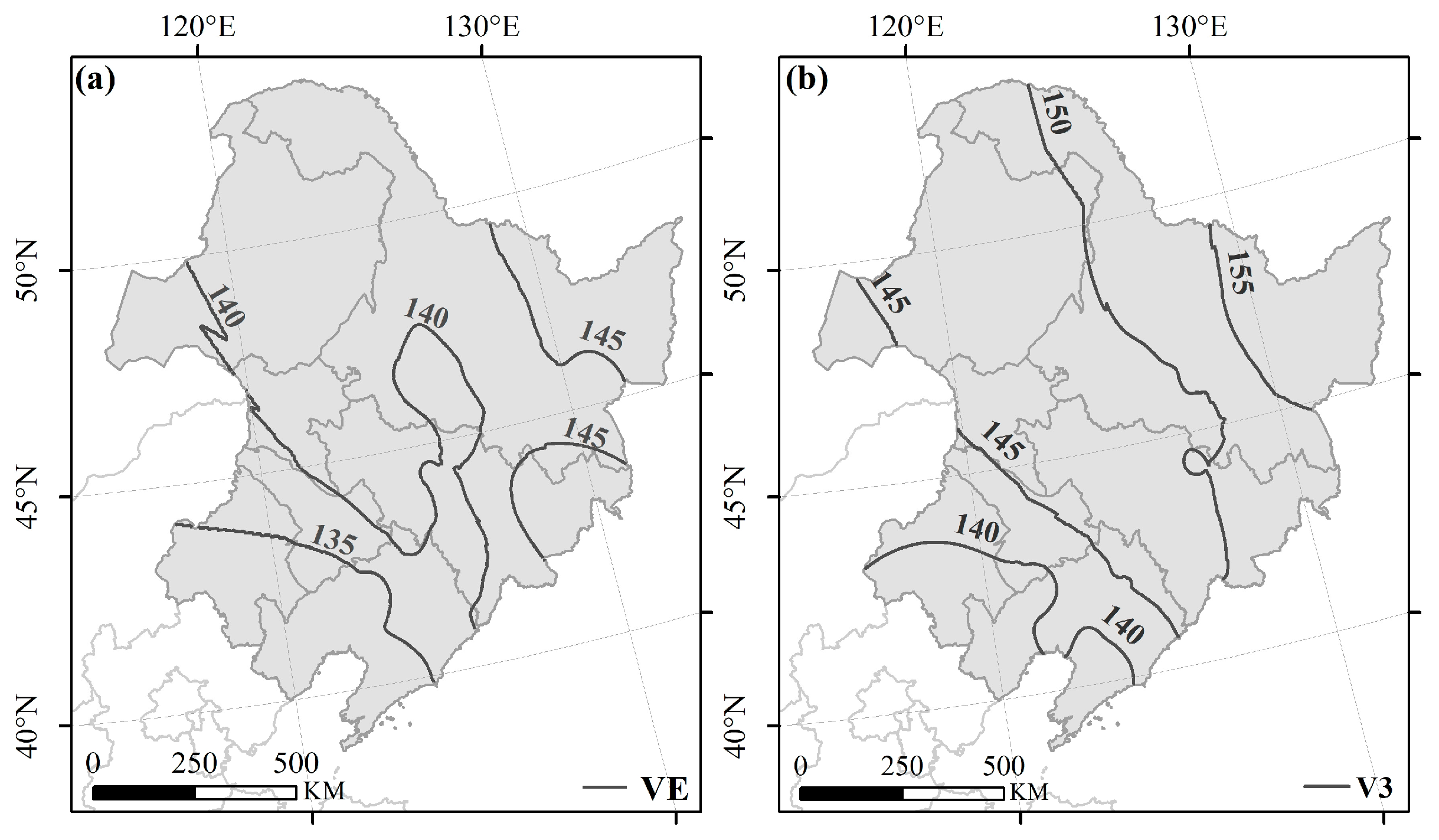


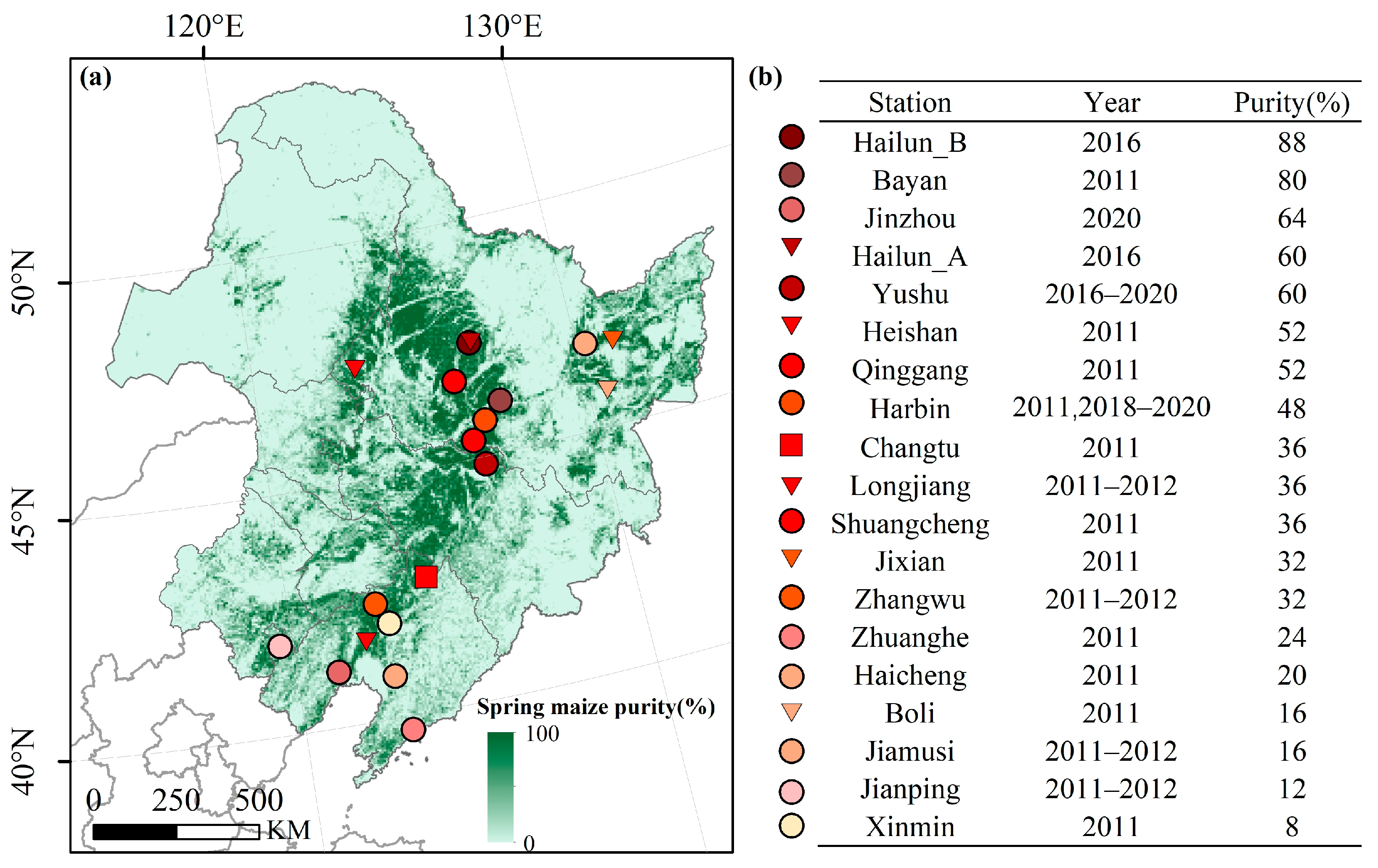
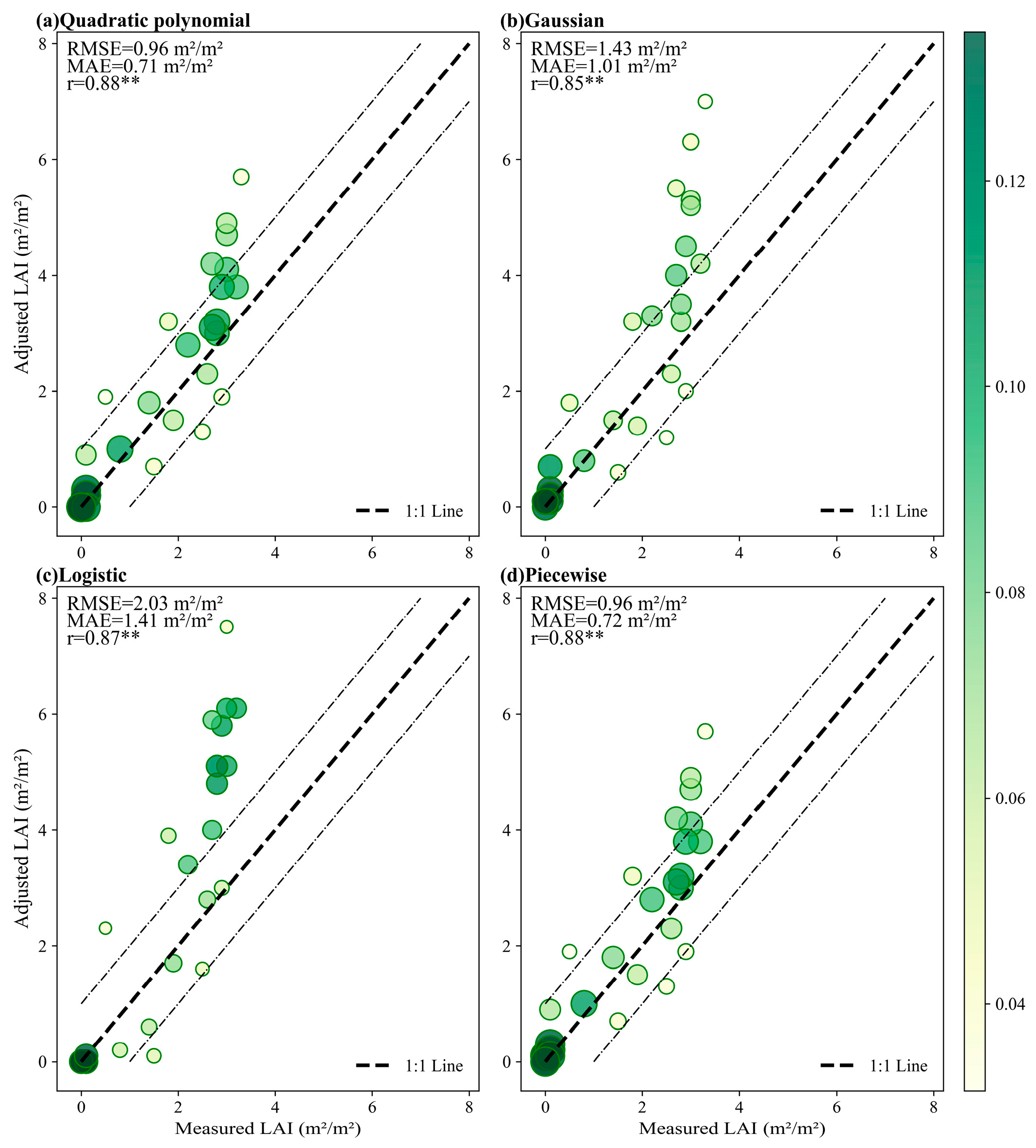
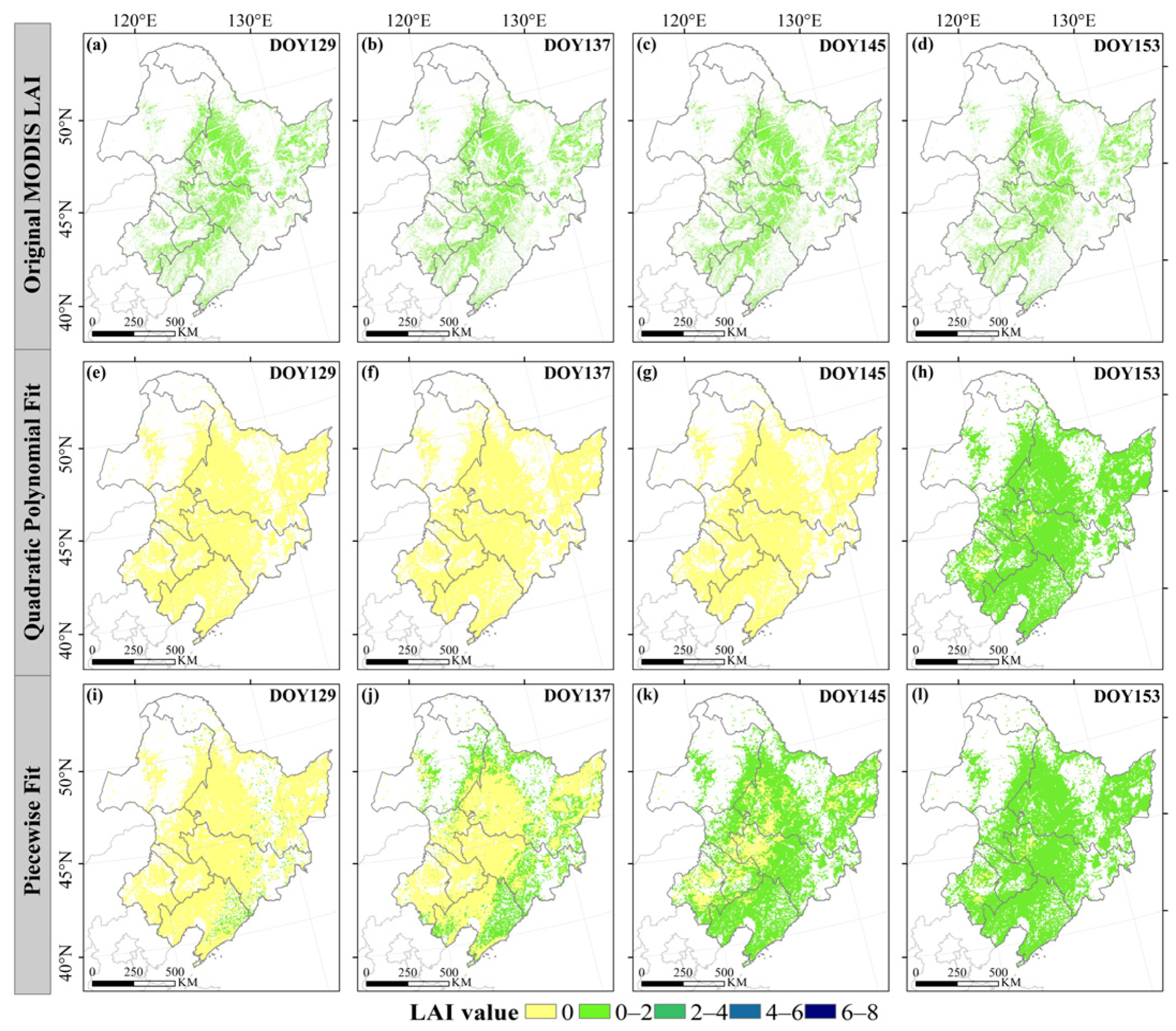
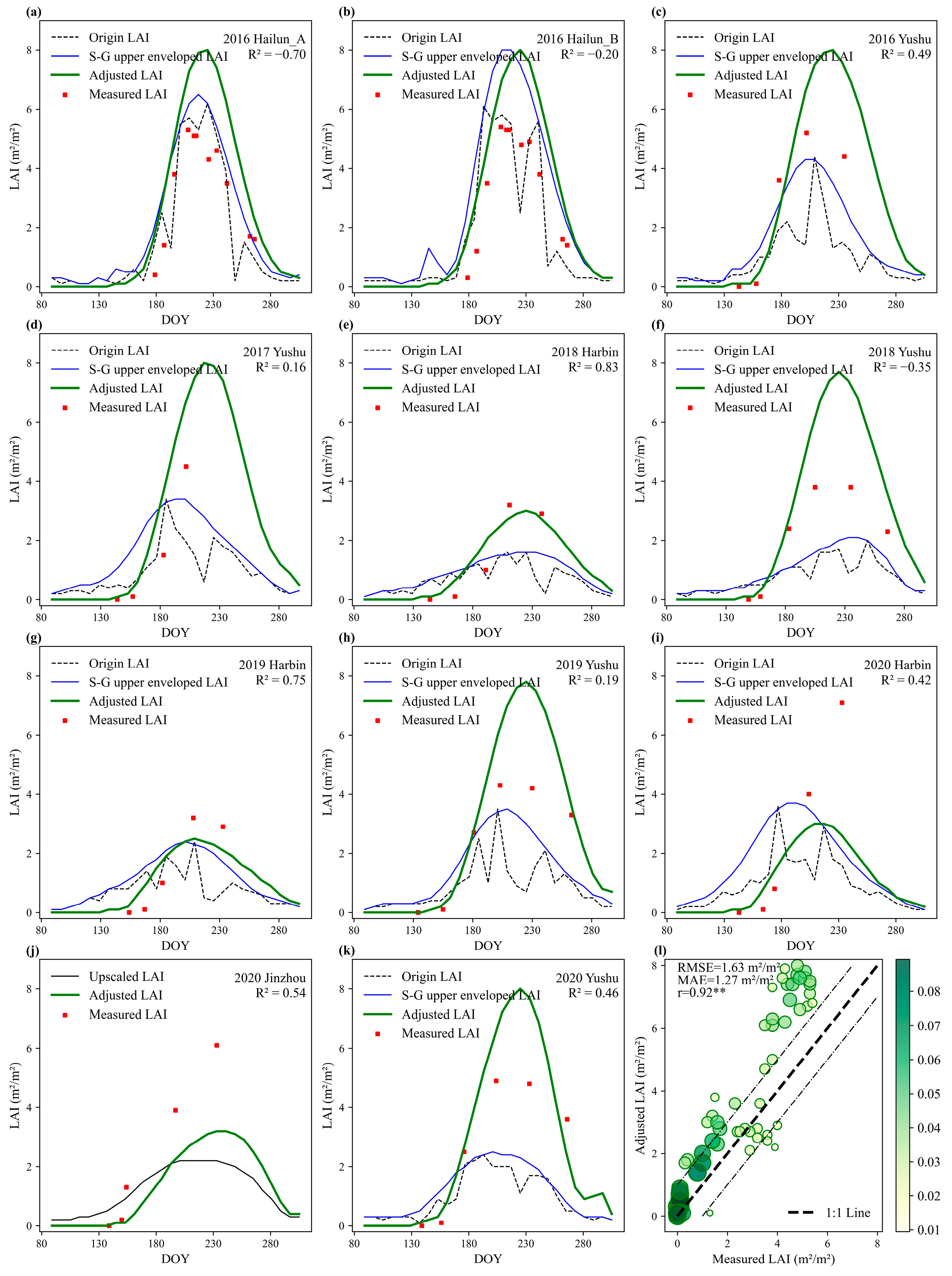
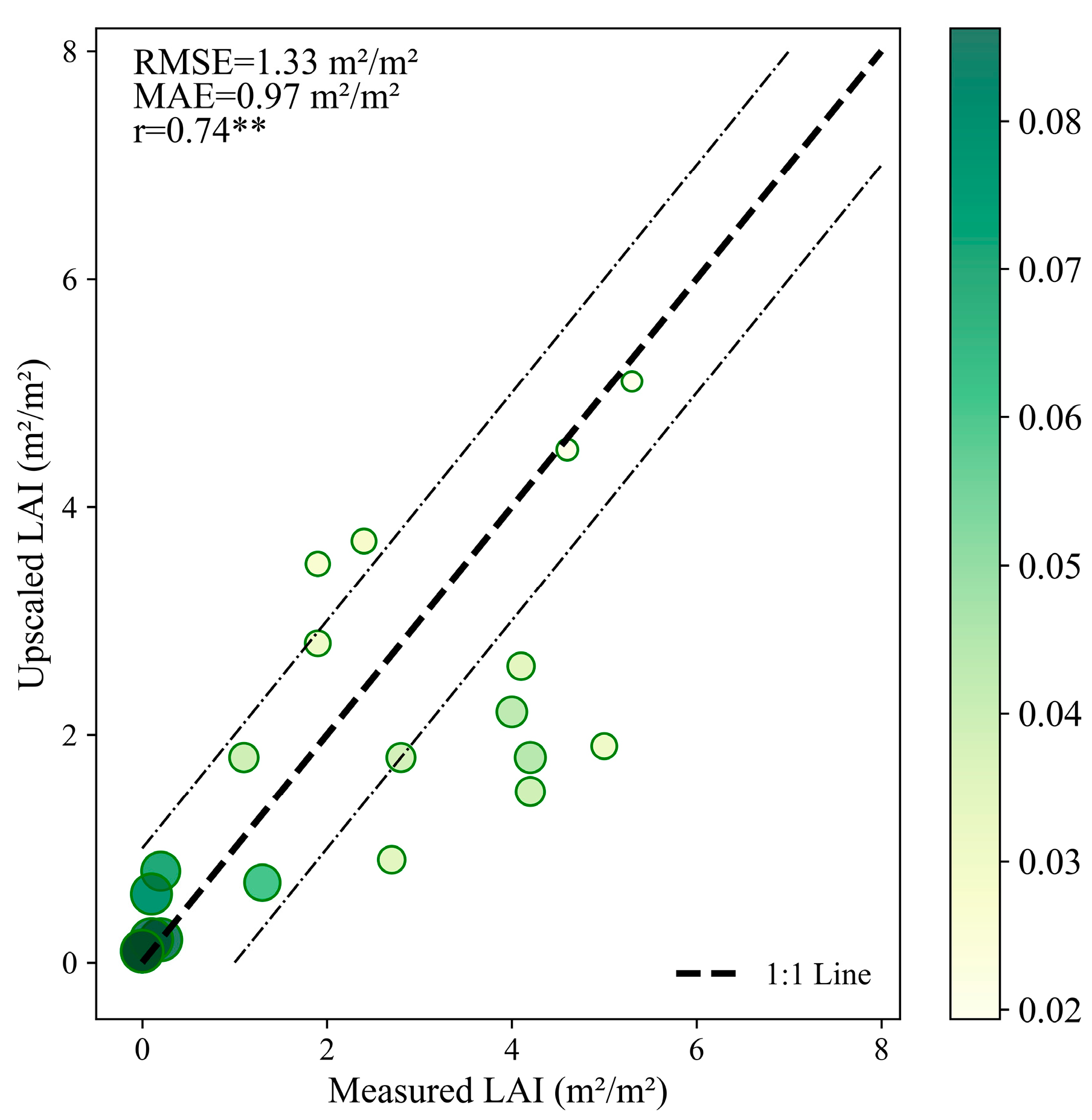

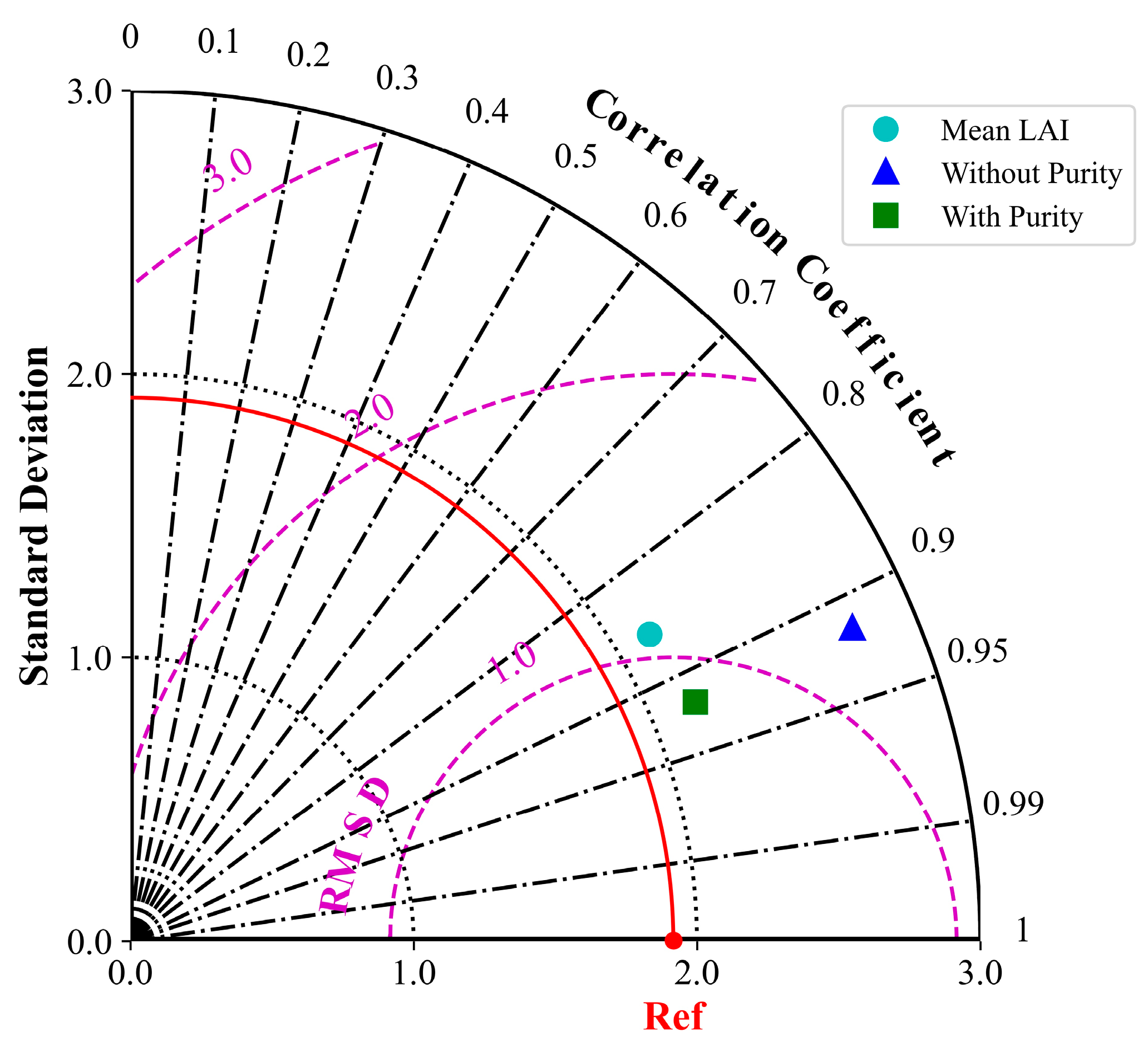
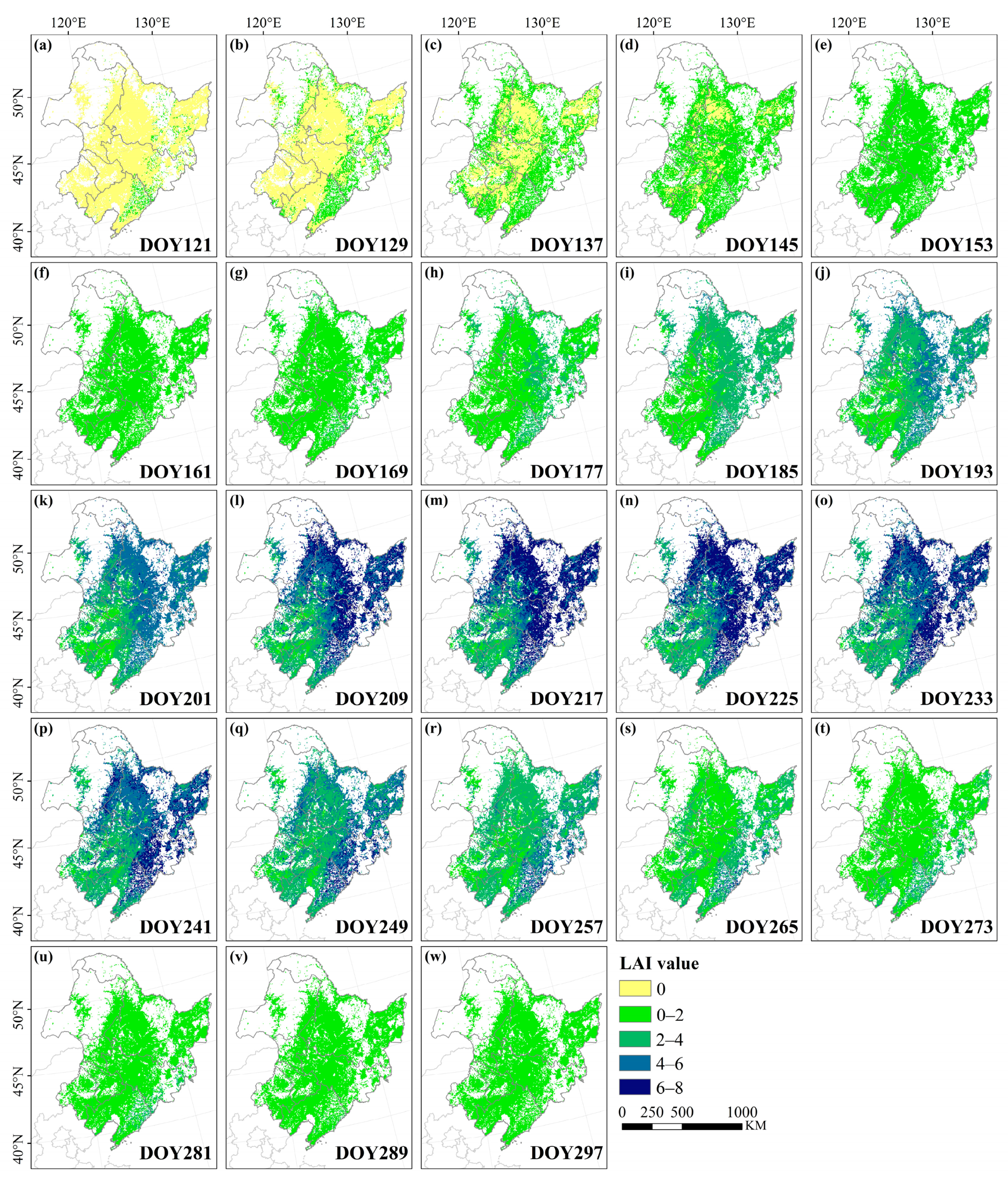

| Data Sources | Time Scale | Purpose | Number of Observed LAI Sites | Number of Observed LAI Samples |
|---|---|---|---|---|
| Field observation | 2011–2012 | Modeling | 15 | 111 |
| Joint regional maize experiment | 2018–2020 | Validation | 2 | 28 |
| Agrometeorological crop elements: dry matter and leaf area real-time data | 2016, 2017, 2020 | 3 | 19 | |
| Fang et al., 2019 [15] | 2016 | 2 | 22 |
| Fitting Function | Function Form |
|---|---|
| Quadratic polynomial | |
| Gaussian | |
| Logistic | |
| Piecewise |
| Variables for Accuracy Verification | Formula |
|---|---|
| Coefficient of determination | |
| Correlation Coefficient | |
| Root Mean Square Error | |
| Mean Absolute Error |
| Station Purity | Quadratic Polynomial | Gaussian | Logistic | Piecewise |
|---|---|---|---|---|
| Without purity | 0.47 ** | 0.38 ** | 0.32 ** | 0.48 ** |
| Low purity | 0.45 ** | 0.53 ** | 0.06 ** | 0.45 ** |
| High purity | 0.87 ** | 0.87 ** | 0.89 ** | 0.88 ** |
Disclaimer/Publisher’s Note: The statements, opinions and data contained in all publications are solely those of the individual author(s) and contributor(s) and not of MDPI and/or the editor(s). MDPI and/or the editor(s) disclaim responsibility for any injury to people or property resulting from any ideas, methods, instructions or products referred to in the content. |
© 2025 by the authors. Licensee MDPI, Basel, Switzerland. This article is an open access article distributed under the terms and conditions of the Creative Commons Attribution (CC BY) license (https://creativecommons.org/licenses/by/4.0/).
Share and Cite
Tang, J.; Wang, P.; Feng, R.; Li, Y.; Li, Q. An Approach to Refining MODIS LAI Data Using a Fitting Scale Factor Time Series. Remote Sens. 2025, 17, 293. https://doi.org/10.3390/rs17020293
Tang J, Wang P, Feng R, Li Y, Li Q. An Approach to Refining MODIS LAI Data Using a Fitting Scale Factor Time Series. Remote Sensing. 2025; 17(2):293. https://doi.org/10.3390/rs17020293
Chicago/Turabian StyleTang, Junxian, Peijuan Wang, Rui Feng, Yang Li, and Qing Li. 2025. "An Approach to Refining MODIS LAI Data Using a Fitting Scale Factor Time Series" Remote Sensing 17, no. 2: 293. https://doi.org/10.3390/rs17020293
APA StyleTang, J., Wang, P., Feng, R., Li, Y., & Li, Q. (2025). An Approach to Refining MODIS LAI Data Using a Fitting Scale Factor Time Series. Remote Sensing, 17(2), 293. https://doi.org/10.3390/rs17020293







